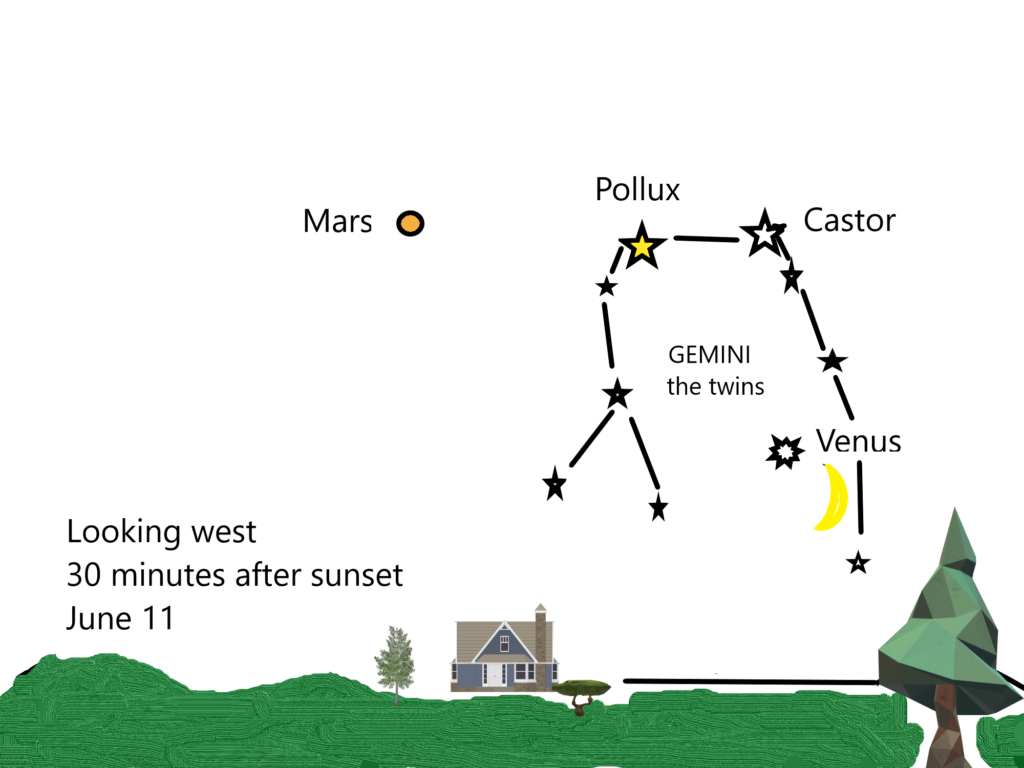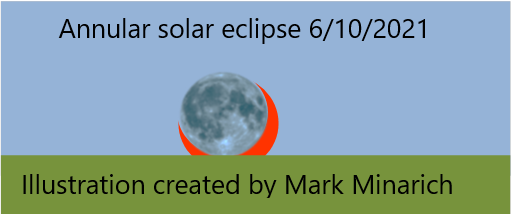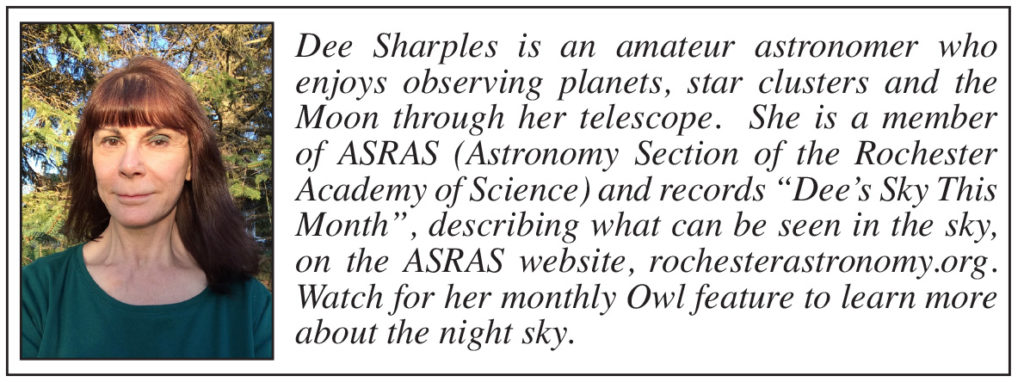Night Sky
- DEE SHARPLES –
Annular Solar Eclipse
There are some pretty sights in the evening sky in the west shortly after sunset in June. The brilliant planet Venus shines at magnitude -3.9 and is easy to find low near the horizon. The “red planet” Mars is dimmer at magnitude 1.7 and shares the same area of sky. On June 11th, a slender crescent moon and bright Venus lie closer to the horizon. That same evening compare the color of Mars to two nearby stars Pollux and Castor in the constellation Gemini the twins when they are almost in a straight line. Castor shines white, while Pollux is yellow-orange, closer to the color of orange-hued Mars.

You can spot the gas-giant planets Saturn and Jupiter in the southeastern sky during the early morning hours about 30 degrees up from the horizon. (The area of the sky covered by your fist measures about 10°.) They move toward the southern sky as the month progresses. Jupiter is brilliant at magnitude -2.4 and brightens to magnitude -2.6. Saturn is dimmer at magnitude 0.3 but still easy to spot to the right of Jupiter. To put these brightnesses in perspective, the Sun shines at magnitude-26.7; the full moon at magnitude -12.6; and the dimmest star visible with the unaided eye at 6.0 to 6.5.
June offers a chance to observe an Annular Solar Eclipse, but it will mean rising early to catch its brief show. The eclipse will be well underway as the sun rises in our area on Thursday, June 10th and be visible only from 5:31AM to 6:36AM. The Astronomy Section of the Rochester Academy of Science (ASRAS) will support safe, projected viewing of the event from Charlotte Pier in Ontario Beach Park, Hamlin Beach Park, and Martin Road Park in Henrietta. The Rochester Museum and Science Center will also support the public observing at Hamlin Beach Park and Martin Road Park.
Warning: Viewing the sun’s disk through any kind of optical aid like binoculars or a telescope, or even the viewfinder of a camera, is extremely dangerous and can cause irreversible eye damage. Projected viewing which is being offered at the three locations mentioned uses a method to project the image of the eclipse onto a white surface, which is totally safe.
An annular solar eclipse is different than a total solar eclipse and occurs when the moon lines up between the sun and the Earth but the moon is farther away than average from our planet. This causes the moon to appear smaller to us and not quite cover the entire surface of the sun, as it does in a total eclipse, but leaves exposed a ring of solar photosphere at the center line of the eclipse.
This eclipse will be fully on display in the extreme northern areas of Canada, Greenland, and the Arctic Ocean as well as northeastern Russia, but by the time the sun rises here, it will be nearing its end. The surface of the sun will be partly covered by the new moon and create a phenomenon called the “Devil’s Horns”.

The above illustration created by Mark Minarich, President of ASRAS shows the “Devils’s Horns” phenomenon. Mark explained, “What is happening is that the sun will rise with the moon eclipsing the top left of it so the shining part of the sun will look like horns rising from the horizon. 78% of the sun will be eclipsed at sunrise.”
For a fantastic video captured over the water during the December 26, 2019, annular eclipse, check out weather.com/news/trending/video/devil-horns-rise-from-the-horizon-during-eclipse
The summer solstice occurs at 11:32 P.M. EDT on June 20th this year. This is the moment when the North Pole has its maximum tip toward the sun and signals the first official day of summer for the northern hemisphere.
